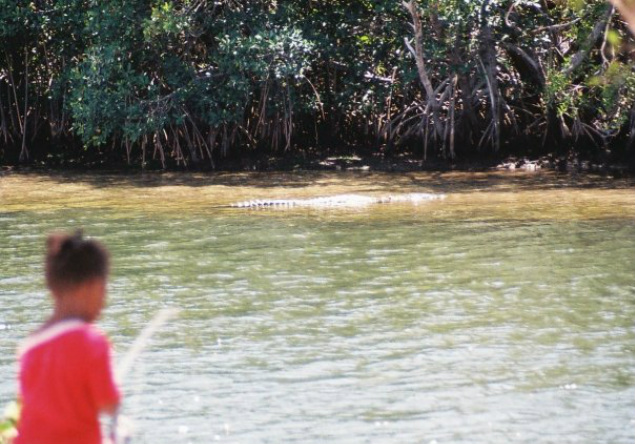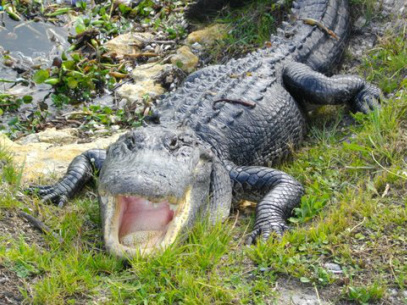Crocodiles & Alligators in Florida
Monsters in our Backyard
Tarzan leaped from a tree into the murky river below. As soon as he hit the water, a large crocodile plunged off the bank and began swimming furiously towards him. The croc was at least eighteen feet long and weighed close to a ton, nearly three times the size of its potential prey and ten times its weight. Before Tarzan had a chance to react, the giant reptile was on him, and within seconds they were embraced in a struggle for life and death. Inevitably, Tarzan would triumph, after all, if he didn’t the movie wouldn’t have lasted very long. But, in real life, no man, not even one raised by apes, would’ve survived, not if the croc was hungry.
Crocodiles and their close relative’s, alligators, have existed largely unchanged for more than two hundred million years. They are possibly the most successful predators the world has ever known—or at the very least, its deadliest and most effective fresh water predator. This remains as true today as it was millions of years ago and there are some very good reasons why.
A crocodilian (the family name for both crocodiles and alligators) are amphibians, meaning they are at home in the water and on land. They possess the greatest bite force of any living creature, many times that of a great white shark and some scientists believe close to that of a full grown Tyrannosaurs Rex. A specimen the length of a small bus can disappear in less than two feet of murky water, making them very effective ambush predators. For short distances, they can move as fast as a sprinter on land and as quickly as a motor boat in the water. They can slow their heart rate down to as little as four beats a minute, enabling them to stay submerged for up to two hours. And when a crocodilian seizes its prey it will either drag it into the depths and drown it, or begin to spin like a turbine, ripping it to pieces.
I have been asked why I have such a fascination with these prehistoric creatures, which is always perplexing. A better question would be, why not? Crocodiles and their kin are a holdover from the age of the dinosaurs—the largest of all living reptiles—a glimpse into history before man and a reminder of the true nature of the world.
I am fortunate to live in South Florida, the only place on earth where large salt water crocodiles and alligators co-exist. I have spent many hours filming and photographing them in their natural habitat, oftentimes marveling at these magnificent creatures at little more than a few feet’s distance.
Crocodiles and their close relative’s, alligators, have existed largely unchanged for more than two hundred million years. They are possibly the most successful predators the world has ever known—or at the very least, its deadliest and most effective fresh water predator. This remains as true today as it was millions of years ago and there are some very good reasons why.
A crocodilian (the family name for both crocodiles and alligators) are amphibians, meaning they are at home in the water and on land. They possess the greatest bite force of any living creature, many times that of a great white shark and some scientists believe close to that of a full grown Tyrannosaurs Rex. A specimen the length of a small bus can disappear in less than two feet of murky water, making them very effective ambush predators. For short distances, they can move as fast as a sprinter on land and as quickly as a motor boat in the water. They can slow their heart rate down to as little as four beats a minute, enabling them to stay submerged for up to two hours. And when a crocodilian seizes its prey it will either drag it into the depths and drown it, or begin to spin like a turbine, ripping it to pieces.
I have been asked why I have such a fascination with these prehistoric creatures, which is always perplexing. A better question would be, why not? Crocodiles and their kin are a holdover from the age of the dinosaurs—the largest of all living reptiles—a glimpse into history before man and a reminder of the true nature of the world.
I am fortunate to live in South Florida, the only place on earth where large salt water crocodiles and alligators co-exist. I have spent many hours filming and photographing them in their natural habitat, oftentimes marveling at these magnificent creatures at little more than a few feet’s distance.
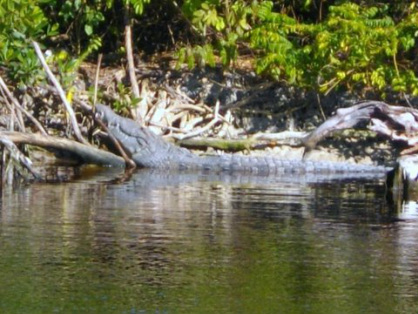
A few years ago, I was in the everglades shooting film of one of my favorite subjects—a twelve-and-a-half-foot, seven-hundred-pound, male crocodile that had staked out the territory in Flamingo at the southernmost tip of the everglades. During the day, he tended to sit on the edge of the bank, in full view, sometimes he would lay between two logs, his enormous head propped up on the edge of one log, with his body and tail streaming down the other—absorbing the sun’s rays like a giant reptilian solar panel. His harem of smaller female crocs was never far away, with the other large males off in the distance, keeping a considerable expanse between him and them. To the right, not more than twenty feet away was a family, father, mother and two small children in a canoe watching this massive creature with awe and curiosity. People are told that these animals pose no real threat to humans and that only one person has ever been killed by a crocodile in Florida. Crocodilians are essentially pure instinct, they have very small brains, but have the ability to learn and adapt quickly, altering their behavior when hunting. They also have sensors over most of their body that allow them to pinpoint prey moving in the water, even in total darkness. If the small canoe were to tip, something that’s very easy to do in a canoe, the croc would most likely respond to the splashing like it would to wounded prey—and if it was hungry, the outcome could have been tragic.
Croc populations in S. Florida have never been more than a few thousand, and those numbers were as low as a few hundred throughout most of the Twentieth Century. Florida’s crocodiles have generally been isolated from human activities, like swimming, where people are most vulnerable to attack. In South America, where these animals exist in larger numbers, there are a few fatalities every year.
The lone death by crocodile in Florida occurred in the early part of the Twentieth Century, provoked by a surveyor that had shot a fifteen-foot specimen and then foolishly, assuming that it was dead approached it, only to find that it was just stunned. The croc woke, turned, grabbed the hunter, and began to spin his enormous body over and over, ripping him to pieces in front of his companions. Strangely, they chose not to kill the animal and instead captured it, selling it to a well-known Florida attraction (I guess profit won out over revenge)! Eventually the killer croc was killed by another Florida native, an alligator named Big George, a notoriously foul-tempered, equally large gator that had a tendency to kill anything or anybody that ventured into his territory. Both animals were separated by a wall keeping them out of the other’s view with the exception of a small hole. The hole was just large enough for the narrower snouted croc to stick the end of his jaws through (crocs have longer, narrower jaws than alligators). Big George seeing an opportunity, clamped down on the snout of the croc, and held it under water long enough to drown it, ending the story of Florida’s killer croc.
Croc populations in S. Florida have never been more than a few thousand, and those numbers were as low as a few hundred throughout most of the Twentieth Century. Florida’s crocodiles have generally been isolated from human activities, like swimming, where people are most vulnerable to attack. In South America, where these animals exist in larger numbers, there are a few fatalities every year.
The lone death by crocodile in Florida occurred in the early part of the Twentieth Century, provoked by a surveyor that had shot a fifteen-foot specimen and then foolishly, assuming that it was dead approached it, only to find that it was just stunned. The croc woke, turned, grabbed the hunter, and began to spin his enormous body over and over, ripping him to pieces in front of his companions. Strangely, they chose not to kill the animal and instead captured it, selling it to a well-known Florida attraction (I guess profit won out over revenge)! Eventually the killer croc was killed by another Florida native, an alligator named Big George, a notoriously foul-tempered, equally large gator that had a tendency to kill anything or anybody that ventured into his territory. Both animals were separated by a wall keeping them out of the other’s view with the exception of a small hole. The hole was just large enough for the narrower snouted croc to stick the end of his jaws through (crocs have longer, narrower jaws than alligators). Big George seeing an opportunity, clamped down on the snout of the croc, and held it under water long enough to drown it, ending the story of Florida’s killer croc.
photo by John Agnew http://www.natureartists.com/john_agnew.asp
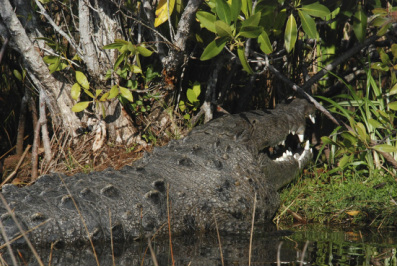
Tales of giant crocs are as old as recorded history and very difficult to verify. No one knows for sure how big they get, maybe twenty-three-feet long and three-thousand pounds, possibly bigger—or even how long they are capable of living—perhaps as long as a hundred years—leaving plenty of room for our imagination to amplify these already mysterious creatures to legendary proportions.
A few years ago The History Channel and MonsterQuest did a story about recent sightings of super-crocs around the world. Two teams of biologists, one in the U.S. and the other in India, hunted for the elusive giants, an alleged twenty-three footer in India and an eighteen-foot monster that was said to lurk in the backwaters of the everglades, in and around my favorite stomping grounds.
Only a few months before the History Channel piece aired I was filming in Flamingo and was having a conversation with one of the workers, he told me about an eighteen-foot giant that had been spotted deeper in the outback. Initially I was skeptical; there are at best two-thousand crocodiles in Florida; the likelihood of an eighteen-footer, a very big animal, even for Africa or Australia, was unlikely. I assumed it was probably the result of an overactive imagination. When the MonsterQuest story verified his claim, I was, like any croc lover would be, enthralled by the possibilities. When my curiosity could be contained no longer, I contacted the two American Biologists from the show and asked about the monster that both had seen, but, was only evident by some fuzzy camera work.
Joe Wasilewski, the leader of the Florida expedition is a well known biologist who has worked with just about every kind of reptile, from cobra’s to Nile crocs. If it’s cold-blooded, crawls, slithers and slinks, Joe Wasilewski is your man. He is one of the few individuals who is allowed to monitor the five-hundred-plus crocodiles that have made the cooling canals in the Turkey Point nuclear power plant in Miami their home. The second biologist was a high school biology teacher named Tony Gerard who has appeared in a number of episodes in the series. Wasilewski said he hadn’t seen the MonsterQuest piece and then told me that the croc in question was possibly a bit bigger that thirteen feet, certainly not eighteen—and Tony Gerard simply said that the MonsterQuest producers lied—so much for super-sized crocs in the Everglades, and for the veracity of the History Channel. The alleged twenty-three-foot animal in India was never officially verified, although a couple of massive specimens were spotted and filmed, suggesting that monster-crocs probably haunt Bhitarkanika National Wildlife sanctuary. These animals are protected in spite of having attacked and killed humans and livestock in the area.
Big croc stories are just like big fish stories—mostly anecdotal and hard to verify. There is occasionally, however, enough evidence to suggest that very large crocodiles are more than a myth. Massive skulls of a variety of species, Nile, American and Saltwater crocs provide tantalizing possibilities, suggesting that exceptionally large animals may in fact, be lurking deep in the rivers and estuaries of Australia, Costa Rica, Africa and the Philippines—three-thousand-pound, dinosaur-sized monsters big enough to consume a man or large animal in only a few bites.
A few years ago The History Channel and MonsterQuest did a story about recent sightings of super-crocs around the world. Two teams of biologists, one in the U.S. and the other in India, hunted for the elusive giants, an alleged twenty-three footer in India and an eighteen-foot monster that was said to lurk in the backwaters of the everglades, in and around my favorite stomping grounds.
Only a few months before the History Channel piece aired I was filming in Flamingo and was having a conversation with one of the workers, he told me about an eighteen-foot giant that had been spotted deeper in the outback. Initially I was skeptical; there are at best two-thousand crocodiles in Florida; the likelihood of an eighteen-footer, a very big animal, even for Africa or Australia, was unlikely. I assumed it was probably the result of an overactive imagination. When the MonsterQuest story verified his claim, I was, like any croc lover would be, enthralled by the possibilities. When my curiosity could be contained no longer, I contacted the two American Biologists from the show and asked about the monster that both had seen, but, was only evident by some fuzzy camera work.
Joe Wasilewski, the leader of the Florida expedition is a well known biologist who has worked with just about every kind of reptile, from cobra’s to Nile crocs. If it’s cold-blooded, crawls, slithers and slinks, Joe Wasilewski is your man. He is one of the few individuals who is allowed to monitor the five-hundred-plus crocodiles that have made the cooling canals in the Turkey Point nuclear power plant in Miami their home. The second biologist was a high school biology teacher named Tony Gerard who has appeared in a number of episodes in the series. Wasilewski said he hadn’t seen the MonsterQuest piece and then told me that the croc in question was possibly a bit bigger that thirteen feet, certainly not eighteen—and Tony Gerard simply said that the MonsterQuest producers lied—so much for super-sized crocs in the Everglades, and for the veracity of the History Channel. The alleged twenty-three-foot animal in India was never officially verified, although a couple of massive specimens were spotted and filmed, suggesting that monster-crocs probably haunt Bhitarkanika National Wildlife sanctuary. These animals are protected in spite of having attacked and killed humans and livestock in the area.
Big croc stories are just like big fish stories—mostly anecdotal and hard to verify. There is occasionally, however, enough evidence to suggest that very large crocodiles are more than a myth. Massive skulls of a variety of species, Nile, American and Saltwater crocs provide tantalizing possibilities, suggesting that exceptionally large animals may in fact, be lurking deep in the rivers and estuaries of Australia, Costa Rica, Africa and the Philippines—three-thousand-pound, dinosaur-sized monsters big enough to consume a man or large animal in only a few bites.
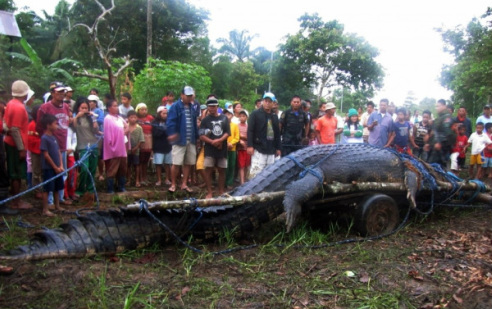
Recently those big croc stories were brought to life with the capture of a two-thousand-three-hundred-seventy-pound, twenty-plus-foot, saltwater crocodile in the Philippines. The giant was said to have recently killed a fisherman and attacked and eaten a young girl. More than thirty men, armed with weapons and traps set out to capture the beast, led by the mayor of the small Philippino town. When they caught the gargantuan reptile in the first trap, it smashed it to pieces; eventually, a second larger, more substantial, trap was successfully used. When the animal was finally subdued, it required more than thirty men to move him, but not before he almost broke free and escaped a second time. It has been reported by the beast’s captors that an even larger crocodile was seen and photographed on their initial hunt. Bunawan creek in the Agusan del Sur in the Philippines may provide a perfect environment for these animals to grow and thrive, away from human activity, with an abundant food supply and no natural enemies.
All crocodilians pose a potential threat to humans, but only three members of the family are considered true man-eaters, Nile and Indio-Pacific crocodiles and American Alligators. Those numbers are probably misleading, since most of the other large members of the crocodile family have been hunted to near extinction. If these animals increase in numbers globally, and humans and crocs come into closer proximity with one another, it’s likely that fatalities will increase. Currently, the exact number of people killed worldwide is unknown, somewhere between a hundred, to potentially a thousand or more people a year. Without accurate record keeping in underdeveloped parts of the world, it’s difficult to know.
Alligators are generally thought to be less aggressive than crocodiles. There are more than 1.5 million gators living in Florida and probably about the same in Louisiana, with a sizable number spread throughout various parts of the Southern U.S. And yet, the number of fatal alligator attacks is relatively low considering the size of both the human and gator population in these areas. I’m inclined, however, to believe that there are a number of variables affecting this. Alligators culls occur annually and they are legally hunted and trapped year ‘round by nuisance gator hunters. Any animal larger than four feet that is found around human habitat is generally destroyed, with their skin and meat sold for profit. This encourages trappers to kill them, instead of trying to relocate them, since alligators have an uncanny homing instinct enabling them to find their way back home, even over long distances. Nuisance hunters can also act as guides for hunters wishing to hunt and kill trophy-sized animals. This means there is a premium placed on killing the big ones. A thirteen- or fourteen-foot animal can bring a guide as much as five thousand dollars or more. Where this is likely to hinder us from ever seeing just how big these animals can get, it probably also saves human life. On the west coast of Florida, they had for a time, a policy of relocating and not killing large gators that entered populated areas. Within a few years, the number of alligator attacks increased, including a few fatalities. In two separate instances a large alligator attacked and killed a woman in her back yard and there was another where an elderly man walking his dog beside a canal was also killed. In both cases the alligators came onto land to attack their victims. On May 10, 2006 a woman was killed in Ft. Lauderdale while dangling her feet in a local canal. The woman was attacked and killed on land by a 10ft. animal. Four days later, two other women were killed by alligators, hundreds of miles apart in different parts of the state.
All crocodilians pose a potential threat to humans, but only three members of the family are considered true man-eaters, Nile and Indio-Pacific crocodiles and American Alligators. Those numbers are probably misleading, since most of the other large members of the crocodile family have been hunted to near extinction. If these animals increase in numbers globally, and humans and crocs come into closer proximity with one another, it’s likely that fatalities will increase. Currently, the exact number of people killed worldwide is unknown, somewhere between a hundred, to potentially a thousand or more people a year. Without accurate record keeping in underdeveloped parts of the world, it’s difficult to know.
Alligators are generally thought to be less aggressive than crocodiles. There are more than 1.5 million gators living in Florida and probably about the same in Louisiana, with a sizable number spread throughout various parts of the Southern U.S. And yet, the number of fatal alligator attacks is relatively low considering the size of both the human and gator population in these areas. I’m inclined, however, to believe that there are a number of variables affecting this. Alligators culls occur annually and they are legally hunted and trapped year ‘round by nuisance gator hunters. Any animal larger than four feet that is found around human habitat is generally destroyed, with their skin and meat sold for profit. This encourages trappers to kill them, instead of trying to relocate them, since alligators have an uncanny homing instinct enabling them to find their way back home, even over long distances. Nuisance hunters can also act as guides for hunters wishing to hunt and kill trophy-sized animals. This means there is a premium placed on killing the big ones. A thirteen- or fourteen-foot animal can bring a guide as much as five thousand dollars or more. Where this is likely to hinder us from ever seeing just how big these animals can get, it probably also saves human life. On the west coast of Florida, they had for a time, a policy of relocating and not killing large gators that entered populated areas. Within a few years, the number of alligator attacks increased, including a few fatalities. In two separate instances a large alligator attacked and killed a woman in her back yard and there was another where an elderly man walking his dog beside a canal was also killed. In both cases the alligators came onto land to attack their victims. On May 10, 2006 a woman was killed in Ft. Lauderdale while dangling her feet in a local canal. The woman was attacked and killed on land by a 10ft. animal. Four days later, two other women were killed by alligators, hundreds of miles apart in different parts of the state.
Another variable that distinguishes alligator aggression towards humans vs. crocodiles is that gators have very little competition for food by other large predators the way crocs do—especially in Africa, the place where the greatest number of fatal attacks occur. Nile crocs are forced to compete with Lions and Leopards, among other animals, oftentimes in areas where lengthy periods of drought force animals to compete for dwindling resources. This includes humans who are forced to the water’s edge in order to survive. When crocs can’t find their normal prey they, like all opportunistic predators will kill and eat whatever and whoever is unfortunate enough to come within their range. A similar phenomenon occurs with Bull Sharks, which are found in freshwater rivers as well as oceans, meaning greater contact with people—even then, some areas have a much higher instance of bull shark attack than others, even where the number of sharks and the corresponding human population is similar. Heavy competition for limited food means you take your meal where you can find it. If humans stray into territory occupied by hungry bull sharks, alligators or crocodiles, the results can be deadly.
Florida appears to be the only place throughout the alligator’s range where attacks on humans is common. Unlike Louisiana, Floridians and gators live in close proximity with one another and that is the primary difference. When trying to determine just how aggressive these animals can be towards human’s, statistics can be misleading. A casual swim in gator or croc territory during daylight is always dangerous, but at night when they hunt and are most active it can very easily be fatal.
With a little common sense regarding crocs and gators we find that they don’t really pose a significant threat to people, at least, not in the U.S., where our wealth insulates us from having to survive at the water’s edge, unlike many other places in the world. This give us an opportunity to experience life, at least in a very limited way, as our ancestors did and in some cases as people still do—and thrill to the possibility of living dinosaurs in our back yard.
At a time when modern man has left his imprint virtually everywhere, it’s reassuring that some things remains outside our reach. I have no desire to experience the world only through the safety of a Disney theme park, a zoo, or from the comfort of my living room. Every once in a while, I have a need to put myself in harm’s way or, at least, at its fringes. A much needed wake-up call to our sedentary and peaceful existence—an adrenalin rush that is sufficient to keep at bay the fear of a premature demise.
As a species, humans have taken the idea of dominion over creation and leveled much of the vast wilderness that is the natural world. And, as unarguably history’s greatest killers, we have reshaped it in our own image, destroying the beauty of the earth and too much of its incredible mystery. We have sought our comfort over the wellbeing of every other living thing and justified it as our manifest destiny.
Crocodiles and alligators are a stark reminder of how fragile life can be—and how mysterious and incredible the world that we live in really is.
Mark Magula
Florida appears to be the only place throughout the alligator’s range where attacks on humans is common. Unlike Louisiana, Floridians and gators live in close proximity with one another and that is the primary difference. When trying to determine just how aggressive these animals can be towards human’s, statistics can be misleading. A casual swim in gator or croc territory during daylight is always dangerous, but at night when they hunt and are most active it can very easily be fatal.
With a little common sense regarding crocs and gators we find that they don’t really pose a significant threat to people, at least, not in the U.S., where our wealth insulates us from having to survive at the water’s edge, unlike many other places in the world. This give us an opportunity to experience life, at least in a very limited way, as our ancestors did and in some cases as people still do—and thrill to the possibility of living dinosaurs in our back yard.
At a time when modern man has left his imprint virtually everywhere, it’s reassuring that some things remains outside our reach. I have no desire to experience the world only through the safety of a Disney theme park, a zoo, or from the comfort of my living room. Every once in a while, I have a need to put myself in harm’s way or, at least, at its fringes. A much needed wake-up call to our sedentary and peaceful existence—an adrenalin rush that is sufficient to keep at bay the fear of a premature demise.
As a species, humans have taken the idea of dominion over creation and leveled much of the vast wilderness that is the natural world. And, as unarguably history’s greatest killers, we have reshaped it in our own image, destroying the beauty of the earth and too much of its incredible mystery. We have sought our comfort over the wellbeing of every other living thing and justified it as our manifest destiny.
Crocodiles and alligators are a stark reminder of how fragile life can be—and how mysterious and incredible the world that we live in really is.
Mark Magula
|
|
|
